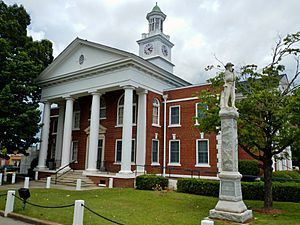Taylor County, Georgia facts for kids
Quick facts for kids
Taylor County
|
|
|---|---|

Taylor County Courthouse in Butler
|
|

Location within the U.S. state of Georgia
|
|
 Georgia's location within the U.S. |
|
| Country | |
| State | |
| Founded | January 15, 1852 |
| Named for | Zachary Taylor |
| Seat | Butler |
| Largest city | Butler |
| Area | |
| • Total | 380 sq mi (1,000 km2) |
| • Land | 377 sq mi (980 km2) |
| • Water | 3.0 sq mi (8 km2) 0.8%% |
| Population
(2020)
|
|
| • Total | 7,816 |
| • Estimate
(2023)
|
7,758 |
| • Density | 20.57/sq mi (7.94/km2) |
| Time zone | UTC−5 (Eastern) |
| • Summer (DST) | UTC−4 (EDT) |
| Congressional district | 2nd |
Taylor County is a county located in the west central portion of the U.S. state of Georgia. As of the 2020 census, the population was 7,816. The county seat and largest city is Butler.
Contents
History
Taylor County was created on January 15, 1852, by an act of the Georgia General Assembly from portions of Macon, Marion and Talbot counties.
The County is named for Zachary Taylor, twelfth President of the United States.
The land for building the courthouse was purchased from Andrew McCants, John T. Gray, John Sturdivant, John L. Parker, and a Mr. Covington. (from a meeting minutes March 8, 1852)
Militia districts in the county included Prattsburg 737, Hall 743, Reynolds 741, Butler 757, Cedar Creek 1071, and Whitewater 853.
Geography
According to the U.S. Census Bureau, the county has a total area of 380 square miles (980 km2), of which 377 square miles (980 km2) is land and 3.0 square miles (7.8 km2) (0.8%) is water.
Taylor County is dissected by the Fall Line geological formation. The upper half of the county is located in the Piedmont region and consists of gently rolling hills and clay-based soils. The lower half of the county is located in the Upper Atlantic Coastal Plain and is markedly flatter and the soil more sandy. The Flint River marks the entirety of the county's northeastern border.
The county is driven by a largely agricultural economy. Peaches, strawberries, pecans, peanuts, watermelons, and cotton are the most commonly raised crops. Lumbering is also important to the local economy. The county is heavily forested in most areas due in part to the many large plantation pine farms. There are also many desirable hardwood forests, especially along the Flint River basin and tributary streams. The southwestern portion of the county is covered with large sandhills that have given rise to several stable sand mining operations.
The county supports a very healthy population of animals, including white-tailed deer, wild turkey, eastern cottontail, raccoon, coyote, bobcat, nine-banded armadillo, Virginia opossum, red-tailed hawk, and the federally endangered Florida gopher tortoise. Taylor County is home to five of North America's venomous snakes (eastern diamondback rattlesnake, timber rattlesnake, Carolina pigmy rattlesnake, eastern coral snake, water moccasin, and copperhead), representing every North American family of venomous snake.
The dominant tree species are southern red oak, post oak, longleaf pine, loblolly pine, sweetgum, and red maple. Taylor County contains the largest stands of Atlantic white cedar in the state of Georgia. These stands can be found along much of Whitewater and Little Whitewater creeks and are at the heart of a growing movement to conserve these unique plant communities for posterity.
The vast majority of Taylor County is located in the Upper Flint River sub-basin of the ACF River Basin (Apalachicola-Chattahoochee-Flint River Basin), with the exception of a tiny corner of the county just north of Georgia, which is located in the Middle Chattahoochee River-Walter F. George Lake sub-basin of the same ACF River Basin.
Major highways
Adjacent counties
- Upson County (north)
- Crawford County (northeast)
- Peach County (east)
- Macon County (southeast)
- Schley County (south)
- Marion County (southwest)
- Talbot County (northwest)
Communities
City
Town
Census-designated place
Other unincorporated communities
Demographics
| Historical population | |||
|---|---|---|---|
| Census | Pop. | %± | |
| 1860 | 5,998 | — | |
| 1870 | 7,143 | 19.1% | |
| 1880 | 8,597 | 20.4% | |
| 1890 | 8,666 | 0.8% | |
| 1900 | 9,846 | 13.6% | |
| 1910 | 10,839 | 10.1% | |
| 1920 | 11,473 | 5.8% | |
| 1930 | 10,617 | −7.5% | |
| 1940 | 10,768 | 1.4% | |
| 1950 | 9,113 | −15.4% | |
| 1960 | 8,311 | −8.8% | |
| 1970 | 7,865 | −5.4% | |
| 1980 | 7,902 | 0.5% | |
| 1990 | 7,642 | −3.3% | |
| 2000 | 8,815 | 15.3% | |
| 2010 | 8,906 | 1.0% | |
| 2020 | 7,816 | −12.2% | |
| 2023 (est.) | 7,758 | −12.9% | |
| U.S. Decennial Census 1790-1880 1890-1910 1920-1930 1930-1940 1940-1950 1960-1980 1980-2000 2010 |
|||
| Race | Num. | Perc. |
|---|---|---|
| White (non-Hispanic) | 4,584 | 58.65% |
| Black or African American (non-Hispanic) | 2,807 | 35.91% |
| Native American | 27 | 0.35% |
| Asian | 29 | 0.37% |
| Pacific Islander | 2 | 0.03% |
| Other/Mixed | 199 | 2.55% |
| Hispanic or Latino | 168 | 2.15% |
As of the 2020 United States census, there were 7,816 people, 3,473 households, and 2,208 families residing in the county.
See also
 In Spanish: Condado de Taylor (Georgia) para niños
In Spanish: Condado de Taylor (Georgia) para niños

